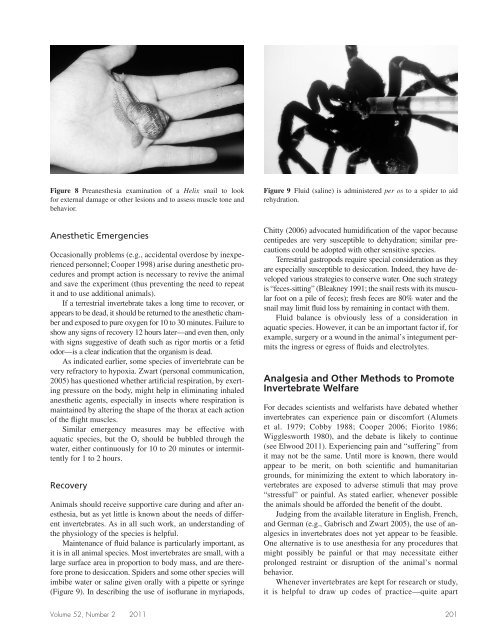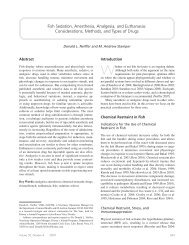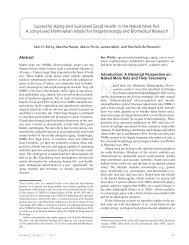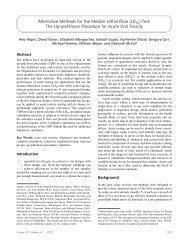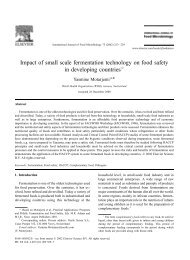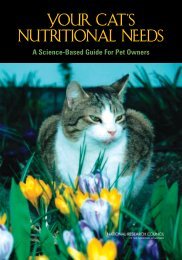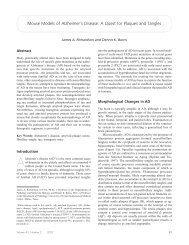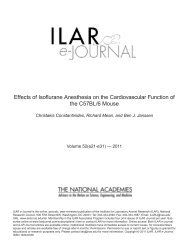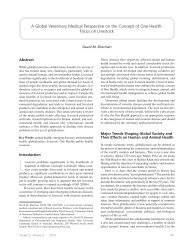Anesthesia, Analgesia, and Euthanasia of Invertebrates
Anesthesia, Analgesia, and Euthanasia of Invertebrates
Anesthesia, Analgesia, and Euthanasia of Invertebrates
You also want an ePaper? Increase the reach of your titles
YUMPU automatically turns print PDFs into web optimized ePapers that Google loves.
Figure 8 Preanesthesia examination <strong>of</strong> a Helix snail to look<br />
for external damage or other lesions <strong>and</strong> to assess muscle tone <strong>and</strong><br />
behavior.<br />
Anesthetic Emergencies<br />
Occasionally problems (e.g., accidental overdose by inexperienced<br />
personnel; Cooper 1998) arise during anesthetic procedures<br />
<strong>and</strong> prompt action is necessary to revive the animal<br />
<strong>and</strong> save the experiment (thus preventing the need to repeat<br />
it <strong>and</strong> to use additional animals).<br />
If a terrestrial invertebrate takes a long time to recover, or<br />
appears to be dead, it should be returned to the anesthetic chamber<br />
<strong>and</strong> exposed to pure oxygen for 10 to 30 minutes. Failure to<br />
show any signs <strong>of</strong> recovery 12 hours later—<strong>and</strong> even then, only<br />
with signs suggestive <strong>of</strong> death such as rigor mortis or a fetid<br />
odor—is a clear indication that the organism is dead.<br />
As indicated earlier, some species <strong>of</strong> invertebrate can be<br />
very refractory to hypoxia. Zwart (personal communication,<br />
2005) has questioned whether artifi cial respiration, by exerting<br />
pressure on the body, might help in eliminating inhaled<br />
anesthetic agents, especially in insects where respiration is<br />
maintained by altering the shape <strong>of</strong> the thorax at each action<br />
<strong>of</strong> the fl ight muscles.<br />
Similar emergency measures may be effective with<br />
aquatic species, but the O 2 should be bubbled through the<br />
water, either continuously for 10 to 20 minutes or intermittently<br />
for 1 to 2 hours.<br />
Recovery<br />
Animals should receive supportive care during <strong>and</strong> after anesthesia,<br />
but as yet little is known about the needs <strong>of</strong> different<br />
invertebrates. As in all such work, an underst<strong>and</strong>ing <strong>of</strong><br />
the physiology <strong>of</strong> the species is helpful.<br />
Maintenance <strong>of</strong> fl uid balance is particularly important, as<br />
it is in all animal species. Most invertebrates are small, with a<br />
large surface area in proportion to body mass, <strong>and</strong> are therefore<br />
prone to desiccation. Spiders <strong>and</strong> some other species will<br />
imbibe water or saline given orally with a pipette or syringe<br />
(Figure 9). In describing the use <strong>of</strong> is<strong>of</strong>l urane in myriapods,<br />
Figure 9 Fluid (saline) is administered per os to a spider to aid<br />
rehydration.<br />
Chitty (2006) advocated humidifi cation <strong>of</strong> the vapor because<br />
centipedes are very susceptible to dehydration; similar precautions<br />
could be adopted with other sensitive species.<br />
Terrestrial gastropods require special consideration as they<br />
are especially susceptible to desiccation. Indeed, they have developed<br />
various strategies to conserve water. One such strategy<br />
is “feces-sitting” (Bleakney 1991; the snail rests with its muscular<br />
foot on a pile <strong>of</strong> feces); fresh feces are 80% water <strong>and</strong> the<br />
snail may limit fl uid loss by remaining in contact with them.<br />
Fluid balance is obviously less <strong>of</strong> a consideration in<br />
aquatic species. However, it can be an important factor if, for<br />
example, surgery or a wound in the animal’s integument permits<br />
the ingress or egress <strong>of</strong> fl uids <strong>and</strong> electrolytes.<br />
<strong>Analgesia</strong> <strong>and</strong> Other Methods to Promote<br />
Invertebrate Welfare<br />
For decades scientists <strong>and</strong> welfarists have debated whether<br />
invertebrates can experience pain or discomfort (Alumets<br />
et al. 1979; Cobby 1988; Cooper 2006; Fiorito 1986;<br />
Wigglesworth 1980), <strong>and</strong> the debate is likely to continue<br />
(see Elwood 2011). Experiencing pain <strong>and</strong> “suffering” from<br />
it may not be the same. Until more is known, there would<br />
appear to be merit, on both scientifi c <strong>and</strong> humanitarian<br />
grounds, for minimizing the extent to which laboratory invertebrates<br />
are exposed to adverse stimuli that may prove<br />
“stressful” or painful. As stated earlier, whenever possible<br />
the animals should be afforded the benefi t <strong>of</strong> the doubt.<br />
Judging from the available literature in English, French,<br />
<strong>and</strong> German (e.g., Gabrisch <strong>and</strong> Zwart 2005), the use <strong>of</strong> analgesics<br />
in invertebrates does not yet appear to be feasible.<br />
One alternative is to use anesthesia for any procedures that<br />
might possibly be painful or that may necessitate either<br />
prolonged restraint or disruption <strong>of</strong> the animal’s normal<br />
behavior.<br />
Whenever invertebrates are kept for research or study,<br />
it is helpful to draw up codes <strong>of</strong> practice—quite apart<br />
Volume 52, Number 2 2011 201


